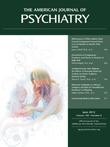While it is widely accepted that early intervention is critical for achieving the best outcome among children with autism spectrum disorders (ASDs), the median age at earliest diagnosis is approximately 4.5 years, according to the Centers for Disease Control (
1). One reason for this is that developmental trajectories in the core deficits seen in autism—language, social interaction, and stereotyped behaviors—are so variable in infants and toddlers. The diagnosis of ASDs is currently based on observations of behavior years after the complex interactions among genetic influences and environmental factors have taken their toll, potentially bypassing treatment or prevention opportunities during the critical first few years of life. Therefore, one of the key goals of the ASD research community has been to identify biomarkers that may predict future diagnosis.
Advances in brain imaging technology over the last few decades have opened immense opportunities for identifying brain biomarkers. In older children and adults, functional magnetic resonance imaging (fMRI) studies have identified several neural systems consistently disrupted in autism, and structural imaging studies examining both gray matter and white matter, including diffusion tensor imaging studies, have noted abnormalities in regional size, white matter volume, and more recently, the growth trajectory of these regions (reviewed by Anagnostou and Taylor [
2]). However, most of these studies have examined older children, adolescents, or adults who have an ASD diagnosis. Because of profound effects of experience on brain development, there is no way to determine whether brain differences observed in older children with autism precede the diagnosis or are a consequence of the diagnosis; that is, reduced social interest, social experience, and impaired development of linguistic competence may alter the trajectory of brain development. There are no data thus far indicating whether some of the brain differences found after diagnosis could also predict future diagnosis in infants who have yet to express behavioral abnormalities associated with autism.
In this issue, a pair of articles address some of these critical questions by examining brain structure in infants at high familial risk for ASDs. In the first report, Wolff and colleagues used diffusion tensor imaging to examine the longitudinal trajectory of white matter development in 6- to 24-month-old infants at high risk for developing ASDs (
3). They assessed each child for symptoms of ASDs and then compared the images from those who did and did not ultimately receive an ASD diagnosis. While all of the infants studied were at high familial risk for ASDs, rates of white matter development over time were significantly lower in those with ASDs than in those without for 12 of the 15 fiber tracts evaluated. Specifically, in most white matter tracts, the ASD-positive infants showed higher fractional anisotropy than the ASD-negative infants at 6 months, followed by lower values at 24 months. These findings are of critical importance, because they are the first to show white matter abnormalities within individuals before the diagnosis itself and during a period of time that could be critical for early intervention among those at high familial risk. The findings further add to a growing model of autism pathogenesis implicating abnormal development of brain connectivity, supported by both structural and functional imaging research in older children, adolescents, and adults.
In the second report from the same research group, Hazlett and colleagues (
4) evaluate differences in brain volumes and head circumference among 6-month-old infants at high versus low familial risk for ASD. The authors predicted and observed no differences in brain volume between the infants at high and low risk, and they suggest that these negative findings are consistent with the notion that brain volume differences occur later in the first year, or early in the second year of life. The authors suggest that these findings are consistent with the notion of experience-dependent synaptic development that occurs during the first few years of life and in which communication, motor, and social experiences help shape the brain and aberrations in these experiences lead to overall aberrations in the brain in individuals with ASDs. Unlike Wolff et al., they did not contrast high-risk infants with and without a 24-month diagnosis of an ASD. Since only about 20% of high-risk infants will develop ASDs (
5), the absence of significant differences in brain volume are difficult to interpret, and “no-difference” hypotheses are particularly difficult to test. These findings are preliminary in the context of ongoing studies from the Infant Brain Imaging Study network, where the authors report that data collection continues. As these infants are followed longitudinally, the trajectory of brain volume differences in infants with ASDs should become more clear.
Could the results from these studies translate into metrics of brain change that are clinically relevant in diagnosis? The absence of a low-familial-risk comparison group in the study by Wolff and colleagues is a significant limitation, making it difficult to determine whether the white matter differences between ASD-positive and ASD-negative participants are indicative of risk for, or resilience to, developing ASDs. Nonetheless, the findings reported, particularly those of Wolff et al., provide a significant advance in the ASD literature. While these studies do not address whether infant imaging findings can predict a future diagnosis of autism, the diffusion tensor imaging results clearly demonstrate brain differences in the first year of life, before behavioral symptoms appear. The data create optimism that developing biomarkers for autism in the critical, preclinical period is possible. Such a development would create an avenue for assessing the impact of preventive interventions, which would be a major breakthrough in ASD research.

